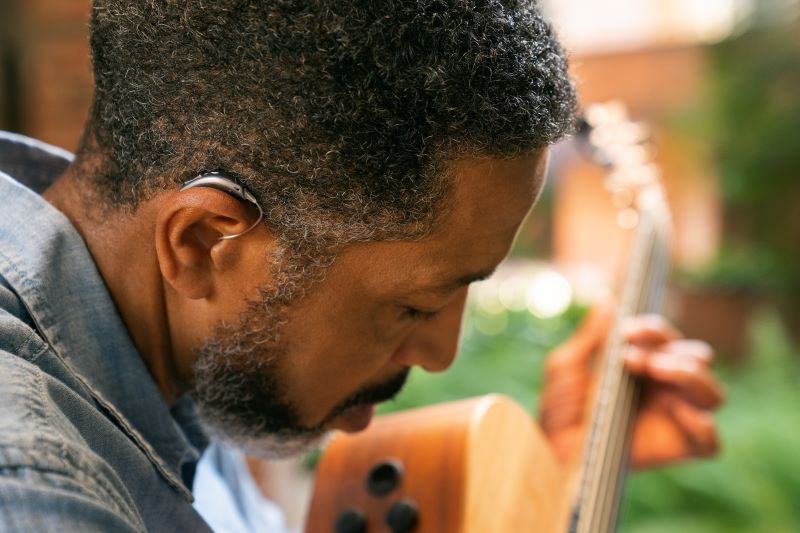|
www.HealthyHearing.com |
What to expect as a new hearing aid userA skilled hearing care provider can provide guidance and customize your devices for unique listening
Contributed by Madeleine Burry Put on a new pair of glasses, and after a few moments of shock at the clarity of what you can see, it’s obvious if glasses are the right prescription, and working properly. But as hearing specialists often mention, hearing aids are a far different solution—glasses restore vision; hearing aids are an aid. That is, your ability to hear will improve, but won’t be restored to youthful strength. So how can you know if your hearing aids are working? Here are ways hearing care providers determine the answer to that question—and what you should keep in mind when it comes to expectations. What hearing aids can do for you
hearing, they will make it easier to hear the sounds you've been missing. For music lovers, ask your hearing care provider to create a device setting for music listening. If you get a new—or first—pair of hearing aids, you'll be able to listen to the TV or radio at a lower volume, says Trisha Muth, AUD, CCC-A, an audiologist based in Maryland. And, when you’re talking to people, instead of craning forward to get closer, or keeping a close eye on lips or body language, you’ll be able to “sit back and relax and let conversation come more easily,” she says. Another change you might notice: a reduction in listening fatigue, or the exhaustion that can accompany the hard work required for people with hearing loss to process conversations. But as mentioned above, hearing aids won’t end or solve your hearing loss completely. “A challenging listening environment is still going to give you challenges, and nothing can give you 16-year-old ears again,” Muth says. That is: At a cocktail party with clinking china and a band playing, you may still find it hard to hear your conversational partner (worth noting: someone without hearing loss—even a teenager!—will also find this type of environment challenging), Muth says. [Overall,] “my gauge of success is how the patient feels,” Muth says—for instance, do you have better communications with friends, easier phone calls when you need help with your internet connection, and so on. If you have a telecoil in your hearing aid, it can connect you to public assistive listening systems, such as hearing loops, FM/DM systems and infrared systems. These are frequently (but not always) found in theaters, event spaces, airports and places of worship. "It's an amazing clear sound that often causes my eyes to water from both the clarity and the emotional impact," says Wynne Whyman, a volunteer committee member for Get in the Hearing Loop, run by the Hearing Loss Association of America. How hearing experts assess your hearing aidsThink of hearing care as involving both art and science. “We first follow the science,” Muth says, getting your prescription in place. But the next step is to get you comfortable, and that’s where the artistry comes through. “The role of an audiologist is so much more than just programming hearing aids,” Muth says. Audiologists and hearing instrument specialists use several different strategies to assess if your hearing aids are working properly: 1. Confirming the hearing aids workEven before your fitting, hearing care providers check on your hearing aid’s performance. They'll use a device known as a test box and take measurements to confirm that the hearing aid is meeting the manufacturer's specifications, Muth says. During this step, your hearing specialist is confirming that the device works as it claims, confirming all the features and functions match the specs. 2. Real ear measurementOnce you’re in the office for your fitting, you’ll participate in real ear measurements, which involves placing a probe in your ear before placing the hearing aids in, and then playing sounds/speech. Doing this measures the output of the hearing aid in your eardrum—while you’re wearing the hearing aid, explains audiologist Ruth Reisman, AuD, MBA, CCC-A, an associate professor at the CUNY Graduate Center and Touro College in New York city. Here’s why this is such a necessary step: Hearing aids are designed to fit an “average” ear, but in fact, ears are as unique as fingerprints, with no two alike, Muth says. So, a hearing aid may fit and emit sound properly in one ear, but need adjustment in another person’s ear. During this stage, you’ll share feedback on what you’re hearing, and the audiologist can make adjustments so the amplification of sound is suitable for your particular ear and hearing loss. They can also set up custom hearing settings, such as for listening to music or birding. “These are the gold standards of programming hearing aids; without it, it's much more of a guess of what's going on,” Muth says. Worth noting: Not all audiologists and hearing instrument specialists take these measurements, Muth says. For instance, just 34 percent of hearing aid dispensers consistently use probe microphones, per a June 2016 review published in the Journal of Otology. If you’re unsure, speak up! Ask your hearing care provider if they plan to do real ear measurement and how they’re verifying the hearing aid’s performance. 3. Validation questionnairesThese methods listed above—confirming the hearing aid meets factory sets and doing the real ear measurement—are objective measurements of the hearing aid’s performance. But audiologists also perform validation measurements, which are more subjective. Basically one half of the project is “verifying that the hearing aids are functioning appropriately, and that they’re improving the patient’s quality of life. And then there is what we call validation, which means that we validate that everything that we've done for the patient was successful,” Reisman says. For instance, Reisman notes that your hearing care professional may give you a questionnaire before fitting you with hearing aids. This is so you can reflect on your experience with hearing loss, your lifestyle, and which listening environments are the most frustrating for you. Then, they will give you the same questionnaire after a few months of using the hearing aids. The goal is for scores to improve over that time period. One questionnaire is the Client Oriented Scale of Improvement (COSI), but there are others available as well. These questionnaires can help highlight successes, such as a higher chance of hearing the doorbell or feeling less embarrassment. They also point out where further improvements might be needed. Muth has a great analogy for why hearing care providers both verify and validate (that is, look at both objective and subjective ways to know if the hearing aids are performing properly): It’s like baking, she says. “Verification is like when you're making a recipe, and you're measuring all the ingredients out. Great, you follow the recipe to a T. But then the validation is: How does it taste?” Sometimes, Muth points out, you may follow a recipe perfectly and precisely, but it still doesn’t taste good. That means adjustments are needed so that the recipe can suit your taste buds and preferences. Another strategy: speech testing
are optimized for conversations and socializing. During speech testing, you’ll listen to a research-based series of words or sentences, Reisman explains. This test is done in the booth, and helps reveal how sounds are being processed by the brain. Speech testing shows if the sound gets to the level of the brain and if it’s processed appropriately or if there’s a deficit or weakness, Reisman says. If there is a deficit or a weakness, auditory rehabilitation might be helpful, since a hearing aid alone can’t resolve a processing issue (meaning the problem is in the brain and not the ears). The idea behind this is that your brain may have learned to compensate for a prolonged or untreated hearing loss, Reisman says. “Pathways will get reestablished, but incorrectly,” she says. Auditory training or rehabilitation works on reestablishing the correct auditory pathways, Reisman says. What if you feel your hearing aids aren’t working properly?First, consider the possibility of a maintenance issue. “You’d be surprised how many patients take their $6,000 hearing aids, wrap it in a tissue, and throw it in their pocket,” Reisman says. To be clear: you should not do that. Aside from storage, consider that hearing aids need to be cleaned (follow your audiologist’s recommendations for how to clean them, and how often) and stored in a dry place, Reisman says. If wax or debris gets on the microphone, you won’t hear as well, she says. Maintenance issues aside, make it your first step to tell your audiologist if your hearing aids aren’t performing as well as you anticipated. There could be a number of factors at play:
But all in all, hearing aids should make a difference—and a positive one. Most people who are embarking on the hearing aid journey are hopeful it’ll improve their quality of life, Reisman says. “And the majority of the time that does [happen] even without additional intervention.” More: 'I literally cried a little' - Read stunning real-life reactions to new hearing aids Madeleine Burry
Related Help Pages:
Hearing aids Types of hearing aids Technology Bluetooth Fitting Cleaning Accessories
|
Featured clinics near me
Earzlink Hearing Care - Reynoldsburg
7668 Slate Ridge Blvd
Reynoldsburg, OH 43068

Find a clinic
We have more hearing clinic reviews than any other site!


 Madeleine Burry is a Brooklyn-based freelance writer and editor. She's written about health for several online publications, including Women's Health, Prevention, Health, Livestrong and Good Housekeeping. You can follow her on Twitter @lovelanewest.
Madeleine Burry is a Brooklyn-based freelance writer and editor. She's written about health for several online publications, including Women's Health, Prevention, Health, Livestrong and Good Housekeeping. You can follow her on Twitter @lovelanewest.